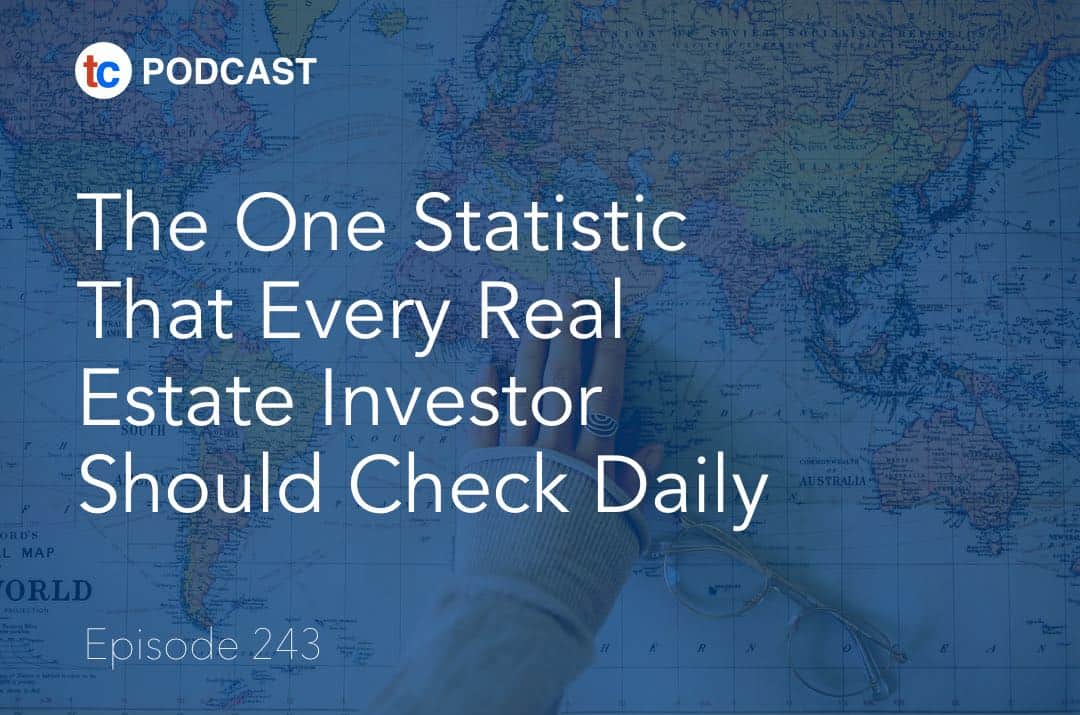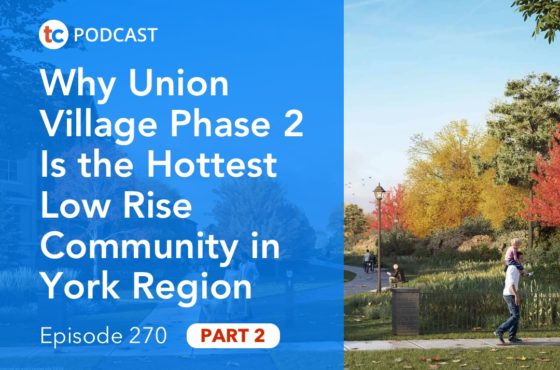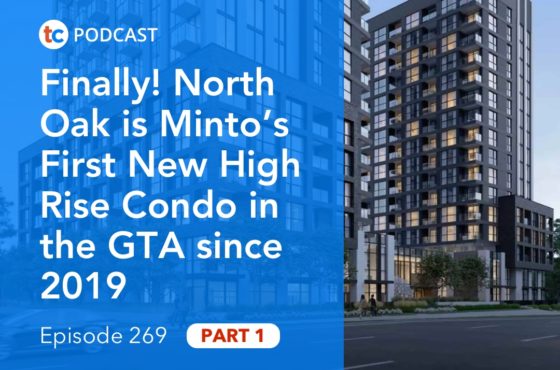The One Statistic That Every Real Estate Investor Should Check Daily

Every day as real estate investors, we are bombarded with headlines around the real estate market and stats are thrown at us like prices up, sales down, new listings etc. etc. Find out the one statistic that Andrew la Fleur is most interested in checking daily as a real estate investor, and what this means for the future of investing in the Greater Toronto Area.
Click Here for Episode Transcript
Andrew la Fleur:
What’s the one statistic that I check every day as a real estate investor? Find out on today’s episode.
Announcer:
Welcome to the True Condos Podcast with Andrew la Fleur. The place to get the truth on the Toronto condo market and condo investing in Toronto.
Andrew la Fleur:
Hi there. Welcome back to the show. Thanks for tuning in to the True Condos Podcast. We’re in the midst of a very, very busy fall market. If you’re a regular listener of the show, thank you for your patience, as it’s been a little while since the last episode. But definitely the podcast is not going anywhere. I’m still here, still plenty of great episodes to come, plenty of great guests to come. Bu the scheduling of the episodes in the fall market, sometimes you might see a few in one week, and sometimes you might just see one every week or two. But we’re still here, we’re still coming at you. We’re still bringing you great content. We hope you find value from this. As a real estate investor or a prospective real estate investor, you’re thinking about getting into the market and you’re learning, either way, we’re happy to have you here. I’m happy to have you here. And I really appreciate you taking the time out of your day, whether you’re at the gym, or driving or commuting, or just chilling out, going for a walk. Wherever you are listening to this, I’m glad you’re here.
Andrew la Fleur:
So as I said in the intro, I want to talk to you today and tell you the one statistic that I check every day as a real estate investor. What’s the most important thing that I am interested in every day? So you hear and you see headlines all the time, sales up, sales down, prices up, prices down. It’s a good week, it’s a bad week in real estate. This market is up, this market is not. There’s so many statistics that if you’re following the markets closely as an investor that you can be overwhelmed by what’s happening and you start to wonder what’s important and what isn’t. How do I filter out the noise and what really matters?
Andrew la Fleur:
Well, for me, again, I’ve been doing this a while now. And the longer I do it, the more I take the perspective of being a longterm investor. Not worrying so much about the day to days, the month to month, not even the year to year. I’m really more and more focused as I go on in my career as an investor on the longterm macro trends of what’s happening in the market. I’m thinking about the next five years, the next ten years, in terms of my thinking and analyzing the market to know how to make decisions today. And so the one statistic that I’m most interested in on a daily basis really is quite simple. It’s not prices up or prices down, or sales up, this and that. It’s simply are more people coming to the GTA than we have houses to accommodate them, than we have places for them to live?
Andrew la Fleur:
So yeah, it really comes down to that. As long as that continues, as long as that is a longterm trend that we don’t see changing, then real estate in this marketplace, pretty much of any kind, residential real estate is going to be a great asset to own. As long as we are continually undersupplying the market, prices will continue to rise and rents will continue to rise in the longterm. So that’s the one thing that I’m looking at every day is are we still growing, and are we growing at a pace faster than we are growing our housing supply?
Andrew la Fleur:
So that being said, it’s a bit of a nuance thing. There’s not one website you can go to say is population growth still outpacing new housing supply? It’s not an easy thing to track. So how do we track it? How do we know that it’s true? Well, we can look at hard numbers, we can look at immigration numbers, we can talk about the fact that we know the big news in the past year or so is that immigration targets are going up dramatically from around 300,000 a year up to 330,000, and probably beyond that over the next few years. So we’re going to see a large increase in the number of immigrants that are coming to Canada. And as we know around 40% of them are coming to the greater Toronto area, which amounts to today somewhere around a hundred thousand. But in the next few years, we’re looking at closer to 120, 130,000. That is a massive increase in the population that is coming to us from around the world.
Andrew la Fleur:
And again, these are not the immigrants of your parents or your grandparents. These are very highly skilled, talented people with talents and skills that are coming and making dramatic and immediate impacts into our economy right away. These are educated people in many cases. These are people who already have a decent amount or significant amounts of wealth. But more importantly, they have the skills and the knowledge and the education, in many cases, the connections, to generate wealth here in Canada and to be productive members of societies, to have jobs, to start businesses, and so on. So every immigrant that comes in is a very good thing for our economy, which is a very good thing for us as real estate investors. That’s great.
Andrew la Fleur:
So you compare the people in versus the number of homes and condos that we’re able to build. And again, you’re looking at the last 10 years, and we just can’t seem to build any more than about 25 to 35,000 new homes and condos every year. So 100, going up to around 130,000, people coming into our area. How many homes are we building? 25 to 35,000 homes. In that range. It’s a constant shortfall. Obviously not every one person that comes in needs their own home, but no matter how you slice it and dice it and do the math, we’re definitely well short on an annualized basis.
Andrew la Fleur:
What else can you look at? You can look at vacancy rates. You can look at the fact that vacancy rates all across the GTA are close to zero. For all intents and purposes, they are zero. Anything that goes up for rent is being rented out immediately. We are not dealing with a situation of five, six, seven, eight, ten percent vacancy rates, which is common in many cities across North America. We are dealing with less than 1% vacancy rates, which is basically zero. Anecdotally you can look at rental rates. Just go out, try to find a place to rent. You’re going to see that rental rates are rising dramatically. It’s very hard to find a place to live whether you are looking to buy or looking to rent. No matter where you are in Toronto, across the GTA, across the Greater Golden Horseshoe, it’s tough.
Andrew la Fleur:
And you can also look at things like jobs. If you are a business owner, an employer, go out and try to hire somebody and tell me how that goes for you. As a business owner, and as somebody who employs people, and is in the process regularly of hiring new people, it is very hard to find qualified candidates for work. And if you do find someone, the amount that they’re expecting you to pay them is rising dramatically. The cost for talent is going up and up and up. And again, why is that? The economy is very strong. The job market is very strong. Competition’s very high. So, quality candidates, they’re hard to find even though we’ve got all these people coming here and population is growing. It’s that’s a separate conversation, but it seems to me that our job market is growing faster than our population as well, which is very interesting.
Andrew la Fleur:
So you know, bottom line is Toronto, GTA, is an amazing place to be. We are sort of the preeminent city now in North America. One article that sort of inspired me to do this podcast and this topic is from citylab.com. I’m going to share the link for this in the show notes, which you can always find at truecondos.com/podcast for this episode and all episodes.
Andrew la Fleur:
Headline is Why Are America’s Three Biggest Metros Shrinking? That’s right. America’s three biggest metro areas, New York, Los Angeles and Chicago, are all seeing their populations decline. What the heck is going on here, America? Here we are in Toronto, we’re struggling with the problem where we’re growing too fast, and then we looked down south at our neighbours, and the three biggest metro areas there are shrinking.
Andrew la Fleur:
We’ve talked about this in the podcast before, but again, I just want to continually point this out to you as real estate investors. This, this is the most important stuff. This is the bottom line. This is what you should be living and breathing and talking about with your colleagues and friends and coworkers and family. Why are you doing what you’re doing and why they should too? If you’re so inclined to create other real estate investors and help other people grow their wealth as you are doing, you should be talking to them and pointing to headlines like this. So people understand that what’s happening in Toronto is very unique. We are different. We are not normal. This is a very special time. We don’t know how long this is going to last. But that’s what I said, this is what I’m checking on a daily basis to make sure it’s still happening. As long as this is still happening, this growth that we’re seeing in population, then this real estate boom will continue.
Andrew la Fleur:
So yeah, so check out that article, and it’s very interesting to see that these cities are actually declining. But Toronto is not alone, in a sense. You look across Canada, Calgary, Vancouver, Ottawa, Montreal, there’s many metro areas in many cities in Canada that the population is growing at rates that are far faster than most major cities in the U.S. So this is a Canada wide thing. Canada is a unique country in the world. Toronto is a unique city in a unique country in the world right now. It’s a special time, and we should understand it, we should know about this, and we should take advantage of this as investors by buying real estate assets today for the longterm. Knowing that five, ten years from now, things are going to be much more expensive to buy and to rent than they are today, as long as this trend continues. So it is continuing. There’s no sign of it stopping anytime soon, as I said. In fact, if anything, it’s only going to get bigger. The immigration numbers are only increasing.
Andrew la Fleur:
Another interesting article also in CityLab, related to this, is actually, the headline is, The Cities Where Job Growth Is Outpacing New Homes. So this is interesting. They’re talking about the certain cities in America where there’s actually more jobs than there are homes. So the job market, the economy is growing, the jobs are growing, people are coming to those areas for those jobs, but there’s not enough new homes there. And as a consequence, real estate prices are rising. So we’re seeing something similar, I believe, here in Toronto. Where the job market is growing, it’s attracting people from across Canada and from around the world, population is growing, but we’re not building enough housing to accommodate them. And the article kind of contrasts that with other cities where they’re building too much housing and the jobs are not growing at the rate that the housing is growing. And a lot of those cities tend to be the Sunbelt cities down in the Southern U.S. Think like Texas, Florida, Arizona, those types of areas.
Andrew la Fleur:
So it’s very interesting. We’d like to compare US-Canada a lot. One thing that Canada does not have that the USA has is warm cities, warm climate cities. There are no warm climate cities. We are all cold-climate cities in Canada. We have the border which prevents us from owning any of that warm weather real estate. So you know, a lot of people in the States, obviously they are attracted to moving to warmer cities, and they always will be, and there will always be that pull. So if you’re living in Minneapolis or Chicago or in New York, and things are getting expensive, you have the option, you are an American, you can just move easily if you want to to a warmer climate city and do that. And people will continue to do that, and land is very cheap there, and labour is cheap there, and sprawl is abundant. And so those cities can continue to build out, out, out, out. You can still buy homes for $150,000, brand new homes, in the massive suburban sprawl type areas in those Sunbelt cities.
Andrew la Fleur:
There is no such option if you are a Canadian, right? You can’t just easily move to a warm city. You could move to the U.S., yes, but that’s a whole other thing. You’re then immigrating to a different country, right? So in a sense, this cold weather that we all hate here in Canada is actually, in a way, to our advantage as real estate investors. That we know that there’s this sort of physical barrier that we can go no further than our southern border. There isn’t that option where people will say, you know what, Toronto? Forget you. You’re too expensive. We’re going to move to a Boca Del Canada, or whatever. Some warm Canadian place. There is none. It’s never going to happen. So we have that sort of built-in protection from that kind of phenomena that you do see in the U.S. and that movement from some of these colder climates of people to the warmer climates. And that flow of people is always going to sort of be happening, and that affects you as a real estate investor.
Andrew la Fleur:
You know what else, in terms of Toronto, GTA, it’s still cheap. You look around the world, people are looking at Canada from around the world, global perspective, and we have our Canadian dollar, of course, and they’re looking at us. We may think we’re expensive, but again, in absolute terms, in taking into consideration the Canadian dollar, and in global terms, we are still very cheap compared to most major cities in the U.S.
Andrew la Fleur:
Quality of life is still amazing here in Canada. Amazing here in Toronto, overall. Yes, our weather sucks. Yes, we’d all rather be in Boca Del whatever on the beach and making the money that we’re making here in Canada, but with the warmer weather. But it’s not going to happen. Forget about it. Stop thinking. Go there and vacation, but come back here to Canada. It’s the best place to be. It’s the best place to live. You know that feeling if you’ve been outside of Canada and you come back to Toronto. Everyone experiences that. You feel it, you know it right away when you’re here. We are a unique place in the world, and everybody wants what we’ve got. So it’s a good thing.
Andrew la Fleur:
Yeah. You know, New York City, these metros that are shrinking, I’ll touch on that. You might be saying, well, is Toronto going to start shrinking at some point? It’s just become too expensive. People have to leave. Yeah, I think probably eventually it’s going to reach that point where people are just fed up with the cost of living here, and people will start to leave. But again, where do they go? There’s no warm weather Canadian city for them to go to. You know, I don’t think it’s going to be the same extent as you see in the U.S. where these cities become expensive and they go to other areas where you can live and much cheaper. But yeah, bottom line, I think we’re decades away. We’re several decades away from that level that New York is at, say, right now. We always compare ourself with New York. We’re several decades away from sort of the cost of living in the city of New York versus where we are now living in the city of Toronto.
Andrew la Fleur:
Let’s face it, you can still be an average person and live in the city of Toronto. Yeah, you might not live in a mansion, you might not live in a penthouse, but you can still live here. You can still figure out a way. You can still be in the city. You can still be close to transit and everything else. You can still have quick access to downtown on a normal sort of person’s salary. It’s still possible. New York? Forget it. It’s been gone for decades. So we’re not anywhere close to that point. But yeah, probably eventually we’re going to get there.
Andrew la Fleur:
If I had to guess where things longer term, like 20, 30 years out, where are things going trend wise? I think more and more people will eventually do one of two things. They’re going to live in much smaller places than we’re used to now. Way smaller. Families will live in 5-600 square feet in the city. Or they’re going to move out. People are going to move out to outside the city, to your Hamiltons, to your Kitcheners, to your Barries, to your Peterboroughs. And they’re going to commute, but they’re not going to commute every day. Right? More and more people are going to work from home three days a week, they’re going to commute in one or two days a week. That is more and more already becoming the norm, and I think that that trend will continue big times. So the world will adjust to real estate price.
Andrew la Fleur:
And people who are already in Toronto and own in Toronto, they ain’t leaving. You know? If you bought real estate 10 years ago, you’re not selling. You’re holding onto it. You’re making it work. You see what you’re sitting on. Nobody’s moving, right? It’s like rent control, and now nobody’s leaving their condos because they’re so under-market, and there’s no turnover in rental market. The same thing, we’re seeing it, in the housing market. You’re sitting on an asset you bought for 500,000 and now it’s worth 1.2 and you’re in the city, you’re not selling, you’re not moving. You’re staying where you are and you’re making it work. You were going to have the second kid. You know what? Let’s just keep it at one. You were going to have the third kid? Whatever, let’s keep it at two. Whatever it may be. People are making different decisions and they’re adjusting their lives according to the cost of living, and the cost of real estate in Toronto.
Andrew la Fleur:
So there you go. There you have it. There’s some thoughts for you today. I hope you find some value from that. Love to hear it from you. Of course, anytime you can reach me 416-371-2333. Andrew@truecondos.com, is my email. Love to hear from you your thoughts on this subject, and anything else on real estate investing. I’m here to help you. Hope you found value from this. If you did, share it with somebody that you know. Check out the articles I mentioned in this episode.
Andrew la Fleur:
And as I said, right now, depending on when you’re listening to this, we have a very busy fall market upon us. There’s a lot of great opportunities that are coming seemingly every day. It is that time of the year. And so if you’re looking to invest before the end of the year, this is a great time to do it. We’ve got great opportunities for you. Some of them come and go very quickly within a matter of a couple of days. So please make sure you’re receiving our emails by signing up anywhere with your name and email at truecondos.com. Never miss a thing. Never miss a great investment opportunity. And until next time, happy investing. Have a great week. Talk to you soon.
Announcer:
Thanks for listening to the True Condos Podcast. Remember your positive reviews make a big difference to the show. To learn more about condo investing, become a True Condo subscriber by visiting truecondos.com.







